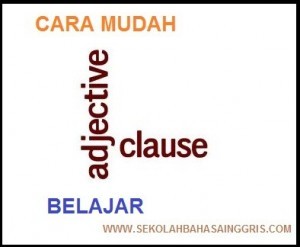Apa Yang Dimaksud Dengan Adjective Clause (Relative Clause)??
www.sekolahbahasainggris.com- Apa sih yang dimaksud dengan adjective clause? Pertanyaan ini sering kali muncul dalam materi grammar baik tentang pengertian adjective clause ataupun kegunaannya.

Adjective clause adalah anak kalimat yang berupa klausa yang berfungsi untuk menjelaskan kata benda (person, things) yang ada di depannya. Kegunaannya untuk mendeskripsikan benda tersebut, mengidentifikasikan benda tersebut, maupun memberikan informasi yang lebih rinci atau detail tentang kata benda baik (subject, object, ataupun di adverb-nya).
Dalam adjective clause atau sering disebut Relative Clause, kita akan mengenal induk kalimat dan anak kalimat, yakni:
- Main clause (independent clause) =Induk Kalimat
adalah sebuah klausa kalimat yang merupakan klausa utama yang akan dijelaskan oleh sub clause (anak kalimat).
-pola: Subject dan Verb
- Sub clause (dependent clause) adalah kalimat yang memiliki pronoun atau frase yang menunjuk pada main noun induk kalimat (main clause)
Bentuk conjuction yang digunakan untuk menghubungkan sub clause dengan main clause:
-
Relative Pronoun – anak kalimat
| Pronoun : |
|
||
| Iyouwe
they he she it |
Meyouus
them him her it |
my …your …our …
their … his … her … its … |
|
| Conjunction : | who (person)which (non person)that (all) | who /whom (person)which (non person)that (all) | whose … (all)of which (non person) |
its …Conjunction : who (person)
which (non person)
that (all)who /whom (person)
which (non person)
that (all)whose … (all)
of which (non person)
-
Relative adverb (Kalimat Penjelas Untuk Keterangan)
when = time
where = place
-
Bentuk-bentuk relative Pronun:
-
RELATIVE PRONOUN FOR SUBJECT (who, which, that)
Contoh :
- I gave the woman a flower : an independent clause
She helped me : an adjective clause
I gave the woman who helped me a flower
that
- The phone is mine : an independent clause
It is on the table : an adjective clause
The phone which is on the table is mine
- RELATIVE PRONOUN OBJECT (whom, which, that)=Pronoun yang berfungsi sebagai object of verb
- The man was Mr. Tri (MC)
I saw him on the street (SC)
→ The man who (m) I saw on the street was Mr. Tri
The man that I saw on the street was Mr. Tri
The man Ø I saw on the street was Mr. Tri
Notes :
“Whom” Tahukah anda :umumnya digunakan hanya pada bahasa Inggris yang formal saja atau dalam writing. Sedangkan dalam percakapan, “whom” bisa ditulis atau diganti dengan “who” walaupun berposisi sebagai objek dalam kalimat.
- RELATIVE POSSESSIVE/ Kepemilikan (whose, of which)
“Whose” digunakan untuk menunjukkan suatu kepemilikan person/benda dalam sebuah kaliamat, yang memiliki arti yang sama dengan possessive adjective (his, her, its, their) yang.
Misal: His bicycle → whose bicycle
Her flower → whose flower
Letak “whose + noun” adalah di awal adjective clause serta tidak bisa diomit (dihilangkan).
- I know the woman (MC)
Her bike was stolen (SC)
→ I know the woman whose bike was stolen.
- The student present the paper (MC)
I read their paper (SC)
→ The student whose paper I read present the paper.
“Noun + of which” digunakan pada adjective clause yang menjelaskan benda:
We have a broken mirror (MC)
The top of it has gold curves (SC)
→ We have broken mirror, the top of which has gold curves.
- RELATIVE ADVERB (where, when)-Where
Where digunakan untuk menjelaskan tempat (seperti city, country, house, etc.) dalam adjective clause.
- The apartment is modern (MC)
She lives there (in that apartment) (SC)
→ The apartment where she lives is modern.
The apartment in which she lives is modern.
The apartment which she lives in is modern.
The apartment that she lives in is modern.
The apartment Ø she lives in is modern.
Notes :
-Jika menggunakan “where” =tidak boleh disertai preposisi seperti “in”,”at”,on”
– tetapi jika tidak menggunakan “where” (jika menggunakan which) maka preposisi harus disertakan.
-“In which” memiliki arti yang sama “where”.
- When
When digunakan untuk menjelaskan waktu (year, day, etc.) didalam adjective clause.
- Kalimat pertama: I celebrated my birthday on march 30th.
- Kalimat kedua: I met you then (on that date)
→
I celebrate my birthday on the date/ march 30th when I met you
I celebrate my birthday on the date/ march 30th on which I met you
I celebrate my birthday on the date/ march 30th I met you
I celebrate my birthday on the date/ march 30th Ø I met you
- RELATIVE STATEMENT (why)
“Why” (menunjukkan alasan) yang dikemukakan oleh si pembicara dari kaliamt ke 1 dan kalimat ke 2. Dan dapat diganti dengan “that” atau dapat juga dihilangkan dalam kalimat.
Kalimat Pertama: I am hungry
Kalimat Kedua: I have not eaten yet
- The reason why I am hungry because I have not eaten yet
The reason Ø I am hungry because I have not eaten yet
Semoga Bermanfaat Para Pembaca SBI!!!!
Related Posts:
